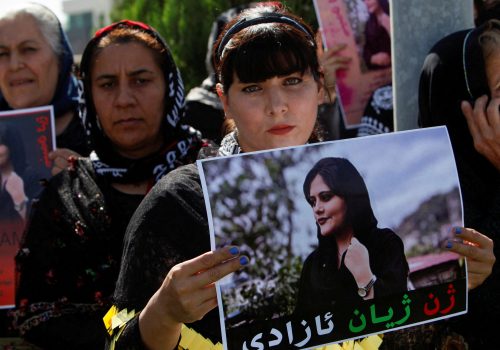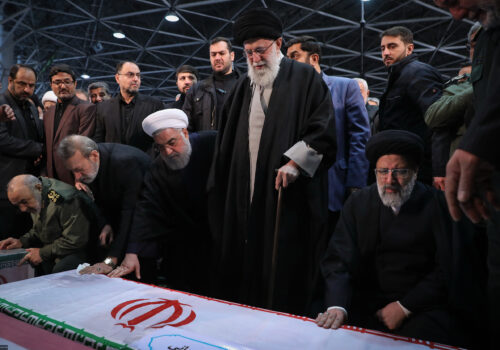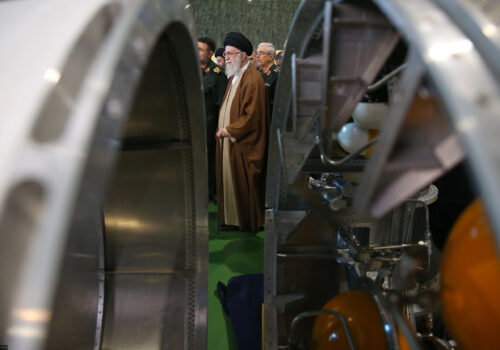The ‘Butcher of Tehran’ is dead. It won’t change a thing.
In June 1989, glasses of wine were raised in our Tehran home when the founder of the Islamic Republic, Ayatollah Ruhollah Khomeini, died. A hushed party had brought together friends and comrades, all of them ex-political prisoners, who by sheer chance had survived the mass executions of the 1980s. Similar parties were held across Iran. The next day, however, a specter of fear haunted all public spaces, with people being fired from jobs even for laughing at jokes unrelated to Khomeini’s death.
Fast-forward to May 20. Millions in and out of Iran, including in Syria and the Gaza Strip, publicly rejoiced when President Ebrahim Raisi died in a helicopter crash along with Foreign Minister Hossein Amir-Abdollahian and several provincial officials.
Since news emerged of Raisi’s helicopter crashing in Iran’s East Azerbaijan province on May 19, people from different backgrounds were glued to their smartphones, anxiously waiting for hours to hear official confirmation of his death, which finally arrived almost fourteen hours later. As Iranians waited, social media were flooded with memes and jokes, and people dancing and drinking in celebration.
A horrible public speaker with a Persian-language Wikipedia page dedicated to his spoonerisms, sixty-three-year-old Raisi never received a proper academic education beyond the sixth grade and was a low-ranking cleric with no charisma. However, after winning the engineered 2021 presidential race that recorded the lowest participation rate in the Islamic Republic’s history, Raisi was promoted overnight to an “ayatollah doctor” by the state media.
His star began rising in 1979. Soon after the Islamic Revolution, when he was nineteen, Raisi was appointed prosecutor of two major cities, Karaj and Hamedan. He was later transferred to Tehran and assigned to the “death commission” that in 1988 extrajudicially executed thousands of political prisoners and dumped their bodies in unmarked mass graves. His role in the mass executions earned him the nickname “the Butcher of Tehran.”
SIGN UP FOR THIS WEEK IN THE MIDEAST NEWSLETTER
A yes-man with blood on his hands, Raisi married Jamileh, the daughter of influential cleric Ahmad Alamolhoda, a close ally of Supreme Leader Ayatollah Ali Khamenei. At the same time, his absolute loyalty was rewarded with wealth. He was appointed as head of Astan Quds Razavi, a corrupt and currently sanctioned financial empire in charge of preserving the gilded shrine of the eighth Shia saint Imam Reza in Mashhad, the second most populated city in Iran.
In 2019, Khamenei appointed Raisi as judiciary chief, a role in which he oversaw a violent crackdown, including the arbitrary arrests of hundreds of peaceful dissidents and rights defenders. Amnesty International has documented that the judiciary under his watch granted “blanket impunity” to security forces to unlawfully kill hundreds of men, women, and children and subject thousands of people to mass arrests and torture during nationwide protests in November 2019.
During Raisi’s short-lived presidency, the Islamic Republic faced the gravest domestic existential threat in its history: the 2022 Woman, Life, Freedom uprising that rocked the country for months and shocked the supreme leader. The regime, with Raisi’s full support, responded to the uprising with brute force, killing hundreds, arresting tens of thousands, and executing at least nine. According to the United Nations, the response amounted to crimes against humanity.
Despite his role in crimes against humanity, Raisi’s celebrated death will have no bearing on the Islamic Republic’s policy. Other than rubber-stamping death and destruction for his own gain, as an absolute opportunist who threw his lot with Khamenei, Raisi’s political life amounted to nothing.
Rubber-stamp president
Since ascending to the throne as supreme leader in 1989, Khamenei has fended off rivals, including former presidents, with house arrest, media silence, banishment from elections, and even alleged assassination. In Raisi, he found an under-educated conformist who practiced absolute subservience, allowing the ayatollah to consolidate his control over all branches of power and secure his legacy with zero resistance.
In Iran, the office of the presidency amounts to nothing but being a “footman,” in the words of two-term former President Mohammad Khatami (1997–2005). Unlike his predecessors, Raisi had no say over Iran’s foreign policy, regional expansionism, or nuclear program. With his death, the supreme leader’s hand will keep the regime on course toward acquiring a nuclear weapon and exporting terror abroad. There will also be no change in the oppression of women and other marginalized groups.
As per the Islamic Republic’s constitution, a presidential election must be held fifty days after Raisi’s death. The interior ministry has already announced June 28 as election day. Raisi assumed office as president in 2021 and was expected to bag an easy reelection in 2025. The rushed race for his seat will create infighting, and possibly put the Islamic Republic on its back foot.
However, even that would not impact the regime’s foreign and nuclear policy, which the supreme leader tightly controls. The Islamic Republic has historically responded to periods of chaos and uncertainty by projecting power abroad. A shift in nuclear policy, a deal with the United States, or a détente between Israel and Hamas would not serve that purpose.
Furthermore, Khamenei has already signaled that he is determined to stay course despite Raisi’s death. During a speech hours before official confirmation of Raisi’s death on May 20, Khamenei calmy proclaimed, “Be reassured people that there will be no disruption in works of the nation.”
At the same time, Raisi’s death has removed a potential contender for inheriting the mantle of supreme leadership after the expected demise of eighty-five-year-old Khamenei. As per the constitution, the Assembly of Experts will fill the position, which again is tightly controlled by Khamenei. According to Reuters, Raisi’s name was already crossed off as a contender some six months ago in light of his incompetence and sagging popularity, reconfirming warnings that the future leader can’t be accurately predicted—that the contenders list is constantly shifting, and the game is far from over.
Hope for change
While regime insiders fight over Raisi’s blood-soaked inheritance and “tear each other limb from limb,” the festivities continue among the people.
Afsaneh Yousefi, whose son Pejman Fatehi was executed alongside three other political prisoners in January, danced to Kurdish music.
Sisters Mahsa and Roya Piraei, whose mother was killed by security forces during the 2021 uprising, clinked drink glasses with smiles sparkling in their eyes.
Clad in a white and blue dress, Mansoureh Behkish, who lost six family members during the 1988 executions, danced with her hair flying in silver tufts.
Esmat Vatan Parast, who lost eleven members of her family in 1980s executions, told Radio Farda, “Yes, the Islamic Republic is still in power, but I wish that the remaining [officials meet a similar fate] so people of Iran can breathe. I wish for a day that the Islamic Republic becomes a thing of the past, that our land is wiped of any sign of these monsters…have faith, our Iran will be liberated.”
And in Raisi’s home city of Mashhad, a young woman with her hair flying free, in defiance of mandatory hijab rules, scribbled on a wall with spray paint, “Khamenei will be next.”
Khosro Sayeh Isfahani is an advocate, journalist, and Internet researcher with years of experience working in Iran, including work related to the LGBTQI community.
Further reading
Wed, Sep 6, 2023
A pilgrimage of love: Mourning the dead in defiance of the Islamic Republic
IranSource By
Over the past weeks, the Islamic Republic has harassed, threatened, detained, and exiled relatives of the victims of state violence.
Wed, Mar 13, 2024
For meaningful change in Iran, Khamenei has got to go
IranSource By
The supreme leader's death will provide people inside Iran and the diaspora with a historic chance to make a foray into fundamental change in the country.
Thu, May 9, 2024
The nuclear fatwa that wasn’t—how Iran sold the world a false narrative
IranSource By
Tracking the supreme leader's comments over the past two decades demonstrates that he never issued a fatwa against building a nuclear weapon.
Image: President Ebrahim Raisi's body was flown back to Tehran on May 21, 2024 (Photo from the president's official website)


